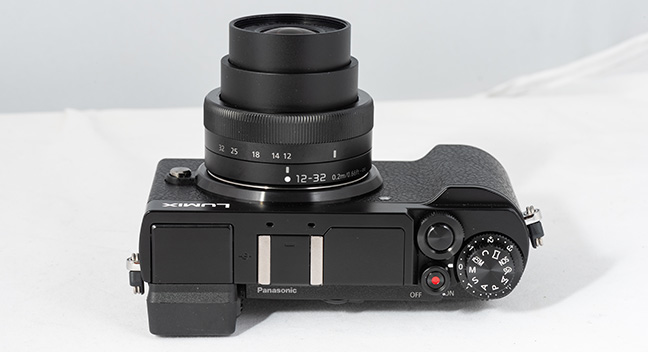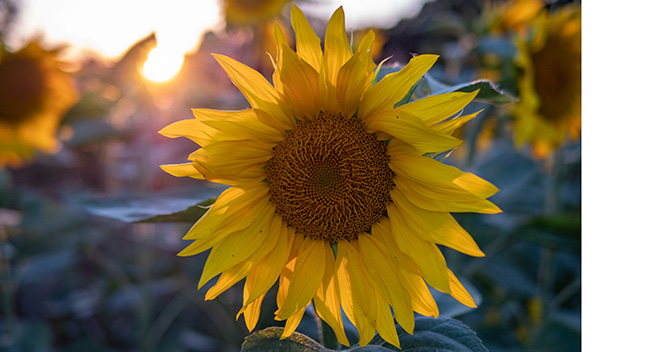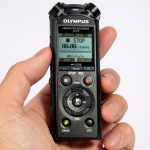
Panasonic Lumix GX9 test: for beginners and beyond
Posted on Oct 11, 2018
The mirrorless bandwagon rolls on relentlessly and Micro Four Thirds is the format of choice for many. Panasonic’s latest mid-priced Lumix is sure to have great appeal for would-be mirrorless newbies
Panasonic currently offers three distinct groups of interchangeable lens mirrorless cameras. The GH series is primarily for videographers, the G is for serious still shooters, and the GX is aimed at keen photographers who demand great image quality, a versatile feature set and high performance.
It’s in the group where the recently introduced Lumix GX9 sits. It sells for £599 body only, or £689 with the camera, including a kit 12-32mm f/3.5-5.6 standard zoom, which puts it at the top end of the
GX family.

A look down its extensive feature list and you can’t help but be impressed. It’s a Micro Four Thirds camera with a 20-megapixel resolution from its LiveMOS sensor, has 4K video photo features and the option of keeping your shooting simple. Or, if you want to take control, you can.
Mid-range cameras can often come at the price of less substantial build in preference for packing in features, but that is definitely not the case with the GX9. While it is not weatherproofed, the body has a reassuringly robust feel that belies the GX9’s price.
In terms of control layout, it is pretty conventional, and we’ll take a body tour in a minute, but let’s start with a feature that is different: the EVF viewfinder eyepiece, top left of the body. It might appear standard, but it isn’t. A gentle push from below and it folds up so you can look down into it. Getting your eye at the right position takes a little practice, and you can find yourself almost poking yourself in the eye with the eyepiece if you are not careful. The idea, though, of giving the option of close-up scrutiny of the scene while shooting from a waist-level or a lower camera viewpoint works well.

So, the GX9 gives you the choice of using the flip-out, touchscreen monitor as a waist-level finder but if you prefer you can use the fold-up EVF finder. By the way, you still get the auto switchover between the monitor and eyepiece, even when it is in the up position.
The EVF image is good, with high resolution and no image smear when panning, with the choice of having camera settings either outside of the image frame or sitting on the image.
As is typical on MFT cameras, the three-inch monitor (which is a touchscreen) dominates the rear panel, with controls along the top ledge and right side. The rear-mounted buttons, while fine to use, are low profile, close to being level with the body, so you need to be precise using them (doing so with gloves is not easy at all). I found some tricky, even with bare hands. The AE/AF button, for example, has a lip surround, and you need to be very positive with your thumb pad to push it in.
That applies to the rear input dial, too, access to which is slightly awkward, with the protruding thumb grip getting in the way. But its action is smooth and pushing it in to confirm settings is no problem.

The AF system uses 49 points across the image and there’s the option of custom multi-zone, where you can set 21, 13 or five zones active, and these zones can be moved around the 49 zone area. There is also the option of a wide single zone or a pinpoint option. The AF system has face/eye detection and tracking modes, too. The size of the active area in tracking is fixed but you can move it around the frame, while the same applies to the face detect setting and here the size of the active area can be altered.
The AF system generally worked really well, and the option of using the touchscreen while your eye is up to the EVF is a nice feature – even though you’ll find your nose can move the AF point around.
If you prefer to move the AF with the four-way cursor, that also works, although it is a two-touch operation. The two input dials can adjust number of zones or AF point size, depending on what’s set.
The four-way cluster and menu set buttons are marginally more raised and that helps using them. The four-way cursor is also used to move the focus point or zone around the image. The AF point/zone can also be moved by finger using the touchscreen, even when the eye is up to the finder eyepiece whatever its position.
The only rear-mounted control that is easy to use is the focus control, where you can switch between single-shot AF, continuous AF and manual focus.

The exposure compensation dial does not feature a locking mechanism, but it is firmly click-stopped and recessed far enough away from the body’s edge that setting it unintentionally is not an issue. The minor downside of its design is that using it needs a little force from your thumb and the action is on the taut side.
Panasonic led the way when it came to 4K photo features and the GX9 is blessed with several options.In 4K photo function you can shoot at 30fps and get file sizes of around 8MB – that is 3328×2496 pixels in 4:3 aspect ratio, so large enough for decent size prints. Other aspect ratios can be set, so 1:1 gives 2880×2880 pixel images.
You can then just view the footage using the control keys on the monitor and pick the image you want to save as a separate JPEG. As you are shooting video, you can in effect shoot hundreds of frames, but of course you have the headache of previewing and selecting images.
Sequence composition is a fun feature – from 4K footage you can create multiple exposure images very easily in-camera, and it doesn’t take long.

You also have the option of Post Focus, which results in JPEGs with plenty of depth-of-field. In this mode, the camera shoots video footage as the lens automatically adjusts focus, from near to far. The process takes a few seconds, so you need to keep the camera steady and, of course, the subject needs to be static. There are other limits, too, with respect to the mode’s effectiveness – great differences between the near and far subjects might mean the merged image does not work, or if you’re using a wide aperture where the bokeh changes significantly through the focusing range, you can end up with strange effects.
An image shot in Post Focus can then give you the option of whether you want the camera to automatically merge your shots, or you can select the point of focus so you can have a good degree of control.
I enjoyed using the Lumix GX9. It has a positive feel, some nice features like the flip-up EVF, and it turns in consistently good results. I did have a few minor handling niggles, though. The low profile buttons and the rear input dial access have already been mentioned. I also found the touchscreen could be frustrating when using the EVF, although this is no reflection on the GX9’s touchscreen and just a generic whinge. I found, for example, the selected focus point was not where I had expected it to be, ie at the centre, because I had inadvertently touched the screen in the course of lifting the camera to my eye. Or I managed to set or change something by touching the screen with my nose.
All told, with consistent autofocus, exposure and auto white-balance performance, good high ISO skills and feature set, the Lumix GX9 showed itself a capable camera.

Performance: Exposure Latitude
For our Raw exposure latitude test, we shot this set at ISO 200 using the Lumix GX9, fitted with a Leica Vario-Elmarit 8-18mm f/2.8-4 lens. The shots were bracketed in manual exposure mode, with the correct exposure being 1/100sec at f/8.
The Raws were processed and exposure corrected in Lightroom CC with no noise reduction applied.
The Lumix GX9’s Raws have decent latitude, and viewed on my test shots you can get it wrong by -4EV and +3EV and still retrieve an image that you can use. Yes, it’s true there is evidence of noise with underexposure at -4EV and -3EV but it is not too heavy and neutral in colour. With a little effort in post-processing, the +3EV shot can be recovered.
Shots poorly exposed by lesser degrees can be recovered with no issue at all and match the correctly exposed image, so I think all round Panasonic’s Raws perform with a good deal of credit.
Click the images to see a larger view
Performance: ISO
This set of low-light shots were taken with the Lumix GX9 on a Manfrotto Beree Advanced GT tripod. The lens was a Leica DG Summilux 25mm f/1.4 and the exposure at ISO 200 was 1sec at f/5.6. In-camera noise reduction was turned off and the Raws processed in Lightroom CC, again with no NR applied. Images were viewed on-screen at 100%.
Go back a few years and Micro Four Thirds could be noisy at quite modest ISO speeds, impacting seriously on image detail, and that noise could be off-puttingly colourful, too. Decent enlargement was not an option if you wanted high-quality results.
How times have changed for the better – the Lumix GX9 did well in the ISO test and if you have to resort to speeds in the higher reaches of the camera’s ISO range, then you will find it a very good performer.
At the sub ISO 800 speeds, images were very clean, detail-packed and nicely saturated. By the time you get to ISO 1600 and 2000 there is evidence of noise, especially in smooth areas of mid-tones. Nevertheless, the files at such speeds are still very usable for serious enlargements, particularly after some noise reduction in processing.
Venture further up the ISO scale to 3200 and noise is more apparent and heavier, although not too obtrusive even when viewed at 100%. Fine details begin to suffer from the beginnings of break-up from this speed and this continues at the higher settings, although even at ISO 6400, overall image quality is still pretty decent.
Verdict
The Panasonic Lumix GX9 is a very capable mirrorless camera with much to like about it, including decent handling and picture quality, and at this price level it is a worthy contender for your cash. Also, with the many lens options available from Leica, Olympus and independent brands as well as from Panasonic itself, you buy yourself into a very versatile camera system with plenty of potential to grow into.
Features: Articulating EVF and monitor, plus 4K photo features, so rates highly
Performance: AF, exposure and white-balance skills all sound
Handling: Some aspects could be better, but nothing serious
Value for money: The Lumix GX9 is a good value for money buy
Overall: The Lumix GX9 shows why Panasonic is a leading player in the mirrorless market
Pros: EVF, good AF, solid build, image quality
Cons: Some minor handling niggles
As featured in issue 59 of Photography News.





















